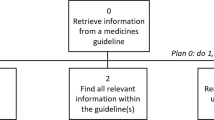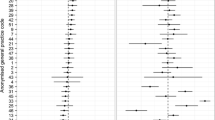Abstract
Objective
To examine the types of prescribing, administration and dispensing incidents reported to an on-line incident-reporting scheme and determine the types of healthcare professionals responsible for reporting such incidents.
Method
Retrospective analysis of medication-related incidents reported to an on-line incident-reporting scheme in a large (1000-bed) teaching hospital in the UK.
Main outcome measures
Frequency and type of incidents, the discipline of the health care professional who reported the incident and the stage in the medication use process (prescribing, dispensing, or administration) at which the incident occurred.
Results
Over a 26-month study period, there were 495 medication-related incidents reported, of which 38.6% (191) were classified to be a “near miss”. Medication-related incidents were reported most often at the stages of administration (230, 46.5%) and prescribing (192, 38.8%), whilst incidents involving dispensing or supply of medication were reported less often (73, 14.7%). Of all the incidents, pharmacists reported 51.9% (257), nursing staff reported 37.6% (186), and doctors reported 9.1% (45). Cardiovascular (149, 30.1%), central nervous system (106, 21.4%), and antibiotic/anti-infective medication (71, 14.3%) were the most common therapeutic categories associated with reports of medication-related incidents.
Conclusion
An on-line reporting scheme can be used to monitor medication-related incidents at key stages in the medication-use process in secondary care. The types of incidents reported by health care professionals differ markedly, with fewer medication-related incidents being reported by doctors. Future research should explore the prevailing safety culture amongst the different health care disciplines, and examine the impact that information technology has on the willingness of health care professionals to report adverse incidents.
Similar content being viewed by others
References
Weingart SN, Wilson RM, Gibberd RW, Harrison B. Epidemiology of medical error. BMJ 2000 March 18; 320(7237):774–7.
Department of Health. An organisation with a memory: a report from an expert working group on learning from adverse events in the NHS. London: Department of Health; 2000.
Kohn LT, Corrigan JM, Donaldson MS. To Err is Human. Washington DC: National Academy Press; 1999.
Department of Health. Building a safer NHS for Patients: improving medication safety. London: Department of Health; 2004.
Department of Health. Building a safer NHS for Patients: Implementing and Organization with a Memory. London: Department of Health; 2001.
Department of Health. Doing less harm. Improving the safety and quality of care through reporting, analysing and learning from adverse incidents involving NHS patients—Key requirements for health care providers. London: Department of Health; 2001.
Dovey SM, Phillips RL. What should we report to medical error reporting systems? Qual Saf Health Care 2004 October;13(5):322–3.
Bates DW. Using information technology to reduce rates of medication errors in hospitals. BMJ 2000 March 18; 320(7237):788–91.
Dean B, Schachter M, Vincent C, Barber N. Causes of prescribing errors in hospital inpatients: a prospective study. Lancet 2002;359:1373–8.
British National Formulary 48 (September 2004). London: British Medical Association and Royal Pharmaceutical Society of Great Britain; 2004.
Tuttle D, Holloway R, Baird T, Sheehan B, Skelton WK. Electronic reporting to improve patient safety. Qual Saf Health Care 2004;13(4):281–6.
Maass G, Cortezzo M. Computerizing incident reporting at a community hospital. Jt Comm J Qual Improv 2000; 26(6):361–73.
Nakajima K, Kurata Y, Takeda H. A web-based incident reporting system and multidisciplinary collaborative projects for patient safety in a Japanese hospital. Qual Saf Health Care 2005;14(2):123–9.
Mekhjian HS, Bentley TD, Ahmad A, Marsh G. Development of a web-based event reporting system in an academic environment. J Am Med Inform Assoc 2004;11(1):11–8.
The Audit Commission. A spoonful of sugar: medicines management in NHS hospitals. Wetherby: Audit Commision Publications; 2001.
Dean B, Schachter M, Vincent C, Barber N. Prescribing errors in hospital inpatients: their incidence and clinical significance. Qual Saf Health Care 2002;11(4):340–4.
Leape LL, Cullen DJ, Clapp MD, Burdick E, Demonaco HJ, Erickson JI, et al. Pharmacist participation on physician rounds and adverse drug events in the intensive care unit. JAMA 1999;282(3):267–70.
Gurwitz JH, Field TS, Harrold LR, Rothschild J, Debellis K, Seger AC, et al. Incidence and preventability of adverse drug events among older persons in the ambulatory setting. JAMA 2003;289(9):1107–16.
Cullen DJ, Bates DW, Small SD, Cooper JB, Nemeskal AR, Leape LL. The incident reporting system does not detect adverse drug events: a problem for quality improvement. Jt Comm J Qual Improv 1995;21(10):541–8.
Stanhope N, Crowley-Murphy M, Vincent C, O'Connor AM, Taylor-Adams SE. An evaluation of adverse incident reporting. J Eval Clin Pract 1999;5(1):5–12.
Leape LL. Reporting of adverse events. N Engl J Med 2002; 347(20):1633–38.
Jha AK, Kuperman GJ, Teich JM, Leape L, Shea B, Rittenberg E, et al. Identifying adverse drug events: development of a computer-based monitor and comparison with chart review and stimulated voluntary report. J Am Med Inform Assoc 1998;5(3):305–14.
Lawton R, Parker D. Barriers to incident reporting in a healthcare system. Qual Saf Health Care 2002;11(1):15–8.
Kingston MJ, Evans SM, Smith BJ, Berry JG. Attitudes of doctors and nurses towards incident reporting: a qualitative analysis. Med J Aust 2004;181(1):36–9.
Jeffe DB, Dunagan WC, Garbutt J, Burroughs TE, Gallagher TH, Hill PR, et al. Using focus groups to understand physicians' and nurses' perspectives on error reporting in hospitals. Jt Comm J Qual Saf 2004; 30(9):471–9.
Miller MR, Clark JS, Lehmann CU. Computer based medication error reporting: insights and implications. Qual Saf Health Care 2006;15(3):208–13.
Lesar TS, Lomaestro BM, Pohl H. Medication-prescribing errors in a teaching hospital. A 9-year experience. Arch Intern Med 1997;157(14):1569–76.
Author information
Authors and Affiliations
Corresponding author
Rights and permissions
About this article
Cite this article
Ashcroft, D.M., Cooke, J. Retrospective analysis of medication incidents reported using an on-line reporting system. Pharm World Sci 28, 359–365 (2006). https://doi.org/10.1007/s11096-006-9040-8
Received:
Accepted:
Published:
Issue Date:
DOI: https://doi.org/10.1007/s11096-006-9040-8




